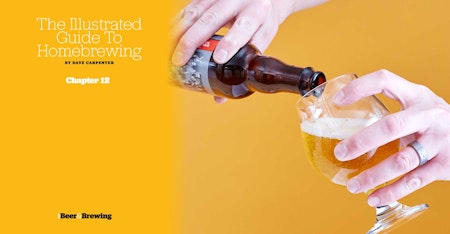A stable crown of rocky foam is a signature hallmark of many a beer style, and brewers go to great lengths to promote a healthy head on each and every pint. From adding a dash of wheat or dextrine malt in the mash to monitoring the cleanliness of glassware, brewers are obsessive when it comes to foam. But what is beer foam and why is it so important?
What Foam Is
Foaming is a complex phenomenon involving the interaction of numerous chemical species. But first you need some bubbles, and to get those bubbles, you need carbon dioxide, or CO2. Before you open a bottle (or pull down the faucet handle), CO2 is dissolved in the liquid beer. But as soon as that beer hits atmospheric pressure, CO2 wants to escape. In fact it has to.
Henry’s Law requires that any gas in solution remain in equilibrium with the gas in the headspace. If you think about it, it makes sense: Imbalance will result in gas diffusing into or out of solution until equilibrium is established. Atmospheric CO2 only exerts about 0.006 pounds per square inch (40 Pa) of pressure at sea level, which is nothing compared to the 12 to 30 psi (83 to 207 kPa) typically dissolved in beer. So carbon dioxide will rush out of a newly opened beer until the amount of CO2 in that beer is accordingly as low as it is in the atmosphere.
But the CO2 doesn’t just neatly diffuse out of solution and into the air. Instead, it forms bubbles. Ever notice those fancy little etchings on the bottom of your favorite pint glasses? Those are nucleation sites, designed to promote the dissolution of carbon dioxide. Nucleation is simply the propensity for any irregularity—etchings, hops particles, Mentos—to promote local dissolution.
As the CO2 bubbles rush upward, various hydrophobic (water repellent) compounds attach to them. These compounds are leftovers from the malt and hops that gave their all to flavor your beer, and they form a kind of protective skin on the outside of each bubble. As the bubbles gather at the top of the beer, they form a raft of foam that stays in place as long as surface tension permits.
What Foam Does
Foam isn’t just pretty to look at: It actually enhances your experience of drinking beer. Much of our sense of taste is better attributed to our sense of smell (try holding your nose as you swallow your next pale ale to experience this firsthand). A good head of foam releases aroma compounds right at the top of the glass as you take a sip, enhancing your perception of the myriad aromatics contained within. And beautiful lacing is, of course, a sight to behold.
What Foam Needs from You
So how do you get that frothy goodness on top of your next beer? Here are some ways to promote foam and head retention:
- Add a bit of wheat malt or Carapils to the mash. These grains promote head retention without noticeably altering the flavor, texture, or color of the beer.
- Use clean glassware. And by clean, we mean clean. Avoid using household detergents, which can accumulate and remain even on apparently clean specimens. Instead, wash glassware by hand with PBW, Oxiclean, or the non-detergent cleaner you use to clean your brewing equipment. Rinse thoroughly, and dry upside down.
- Brew low gravity. There’s a reason that barleywines, Belgian strong ales, and other high-octane styles rarely feature robust heads of foam. Ethanol is a very effective anti-foaming agent. So the higher the alcohol, the lower the foam.
- Don’t add lemon or orange. In addition to being an unnecessary and non-traditional marketing gimmick, garnishing your Hefeweizen with a citrus slice is a surefire way to inhibit head retention.
- Avoid lip balm and lipstick. The lipids (fats) in these substances can destroy the bubbles you’ve worked so hard to create. The same goes for fatty foods, but hey, we’re not ascetics.
Beer foam enhances the presentation and experience of drinking beer. With just a little attention to detail, you’ll be able to pour a perfect pint every time.








